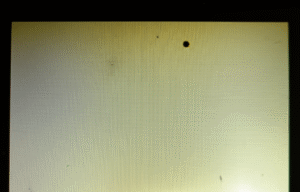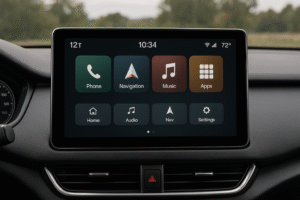A phase-locked loop (PLL) is an electronic feedback circuit that locks an output clock to a reference signal. In an LCD system, the PLL keeps the panel’s pixel clock and sync signals in phase with the main clock or incoming video sync, so each frame and line is timed correctly.
Embedded LCD controllers often use their built-in PLL to generate the exact pixel clock from a system oscillator. For example, one FPGA-based design used a PLL to divide a 50MHz clock down to a 5MHz pixel clock for a TFT LCD panel.
The locked pixel clock then toggles the LCD’s data and sync pulses. ARM’s AMBA LCD controller docs explicitly recommend deriving the pixel clock from the on-chip PLL output, ensuring each new pixel data latch aligns at precise intervals.
In video-receiving LCDs, a PLL can also lock onto the horizontal sync (HSYNC) pulses to recover the pixel clock from the signal. This keeps the display’s sampling clock phase-aligned with the source video, synchronizing each scan line to the correct timing.
How Does a Phase-Locked Loop (PLL) Work in LCD Synchronization?
A phase-locked loop (PLL) works in LCD synchronization by generating a pixel clock that aligns with the display’s resolution and refresh rate. This keeps the timing signals in sync, ensuring the LCD shows clear images without errors.
PLLs play a key role in LCD systems by matching the output signal’s phase and frequency to a reference signal. This precise control allows high-resolution displays to update pixels at the right moment, avoiding issues like flickering or distortion.
- Reference Clock: A stable source, often a crystal oscillator, sets the base frequency for the PLL.
- Voltage-Controlled Oscillator (VCO): This creates a clock signal that adjusts based on a control voltage.
- Phase Detector: It compares the VCO output to the reference clock and tweaks the voltage to keep them aligned.
- Loop Filter: This smooths the control voltage for a steady frequency output.
- Frequency Divider: It adjusts the VCO frequency to fit the exact timing needs of the LCD.
What Are the Benefits of Using PLLs in LCD Synchronization?
PLLs improve LCD performance by enhancing image quality, lowering power use, and supporting varied display designs.
With accurate timing, PLLs help LCDs show sharp, high-resolution images without visual glitches. They also cut power needs by optimizing signal timing, which suits devices like smartphones or tablets well.
- Better Image Quality: PLLs time pixel updates precisely, reducing problems like tearing or ghosting.
- Lower Power Use: Efficient timing signals mean less energy is needed to run the display.
- Design Flexibility: PLLs adapt to different resolutions and refresh rates, fitting many LCD applications.
How Does a PLL Work?
A phase-locked loop (PLL) operates by using a phase detector to compare the phase of a voltage-controlled oscillator (VCO) output with a reference signal, adjusting the VCO through a loop filter until phase lock is achieved, which ensures a steady pixel clock for LCDs. This process synchronizes the output signal with the reference, providing precise timing critical for display applications.
Key Parameters Affecting Performance
Several key parameters influence PLL performance, each playing a unique role in its operation:
- Bandwidth: This determines the PLL’s response speed and ability to reject noise. A narrow bandwidth, such as 100-500 kHz, effectively filters noise but increases the time required to achieve lock.
- Damping Factor: This parameter balances stability and settling time. A value between 0.7 and 1.0 is often used to prevent oscillations (underdamped) or slow locking (overdamped).
- Jitter: These are small timing variations that can cause pixel wander, resulting in visual artifacts like sparkling or blurred edges. Jitter should be kept below 1% of the pixel clock period.
- Lock-Time: The time taken to achieve synchronization, typically needing to be less than a few milliseconds to ensure smooth mode-switching without disrupting the display.
Why Are PLLs Essential for LCD Synchronization?
PLLs are vital for LCD synchronization because they deliver precise timing control, preventing visual artifacts and ensuring smooth operation in high-resolution displays. Beyond this, they enhance image quality by eliminating issues like tearing, reduce power consumption through efficient timing, and provide flexibility to support various resolutions and refresh rates.
- Improved Image Quality: Accurate timing prevents visual distortions such as ghosting or tearing.
- Reduced Power Consumption: Optimized signal timing lowers overall power usage.
- Flexibility in Display Design: PLLs adapt seamlessly to different display requirements.
How Are Phase-Locked Loops Applied in LCD Systems?
A phase-locked loop (PLL) in an LCD system generates the stable pixel clock needed to drive the display. It locks an internal oscillator to a reference and multiplies it to match the screen’s timing requirements. This ensures the LCD’s scan timing (resolution and frame rate) stays precise and jitter-free.
- PLL Operation: A PLL circuit compares the phase of a reference clock and a feedback signal. Its phase detector and loop filter adjust the VCO so the output phase and frequency match the reference. When locked, the PLL output (pixel clock) tracks the reference frequency with minimal error.
- Pixel Clock Calculation: The pixel clock = active pixels × lines × refresh. For example, a 1920×1080 display at 60Hz needs about 148.5 MHz (assuming ~20% total blanking). The system computes
pixel_clock = (HActive+HBlank)*(VActive+VBlank)*RefreshRate. - PLL Configuration: Embedded controllers set divider and multiplier registers to hit the target clock. The formula is:
Fout = Fref * (M / N). Adjust M (multiplier) and N (divider) to match the needed pixel clock, then enable the PLL and wait for it to lock. - Example Configuration: Using a 20 MHz reference and setting M=200, N=25 yields Fout = 160 MHz.
#define REF_CLK 20000000UL // 20 MHz reference clock
#define PLL_MULT 200 // multiplier register
#define PLL_DIV 25 // divider register
uint32_t pixel_clock = (REF_CLK * PLL_MULT) / PLL_DIV; // ~160000000 Hz (160MHz)
Example: Calculating pixel clock from a reference and PLL settings.
- Lock and Timing: Once configured, the PLL achieves phase lock and filters out noise. It maintains a constant frequency despite small disturbances. The locked pixel clock drives the LCD’s horizontal/vertical sync, ensuring each line and frame is timed correctly.
- Embedded Implementation: Modern LCD controllers and embedded LCD systems often include on-chip PLL circuits. For instance, many microcontrollers/FPGA designs use a PLL to multiply a low-speed crystal (e.g. 12–24 MHz) up to the high-frequency clock needed for displays. Software can reprogram the PLL for different resolutions or refresh rates without extra hardware.
Why Use a PLL for the LCD Pixel Clock?
A PLL allows flexible and precise clock generation for different display modes(What Sets Transmissive, Reflective, and Transflective LCDs Apart?). Using an integrated PLL, the controller can be reconfigured by software to match each panel’s resolution and refresh rate, avoiding the need for multiple fixed oscillators. The PLL’s feedback loop then locks that clock to the system reference, giving a stable, jitter-free signal for the LCD timing.
What Advanced PLL Techniques Improve LCD Performance?

Modern LCD clock generators use spread-spectrum modulation and loop optimization. These PLL adaptations dither the pixel clock to reduce EMI peaks and finely tune the loop filter to minimize clock jitter, greatly improving display timing.
- Spread-Spectrum Clocking: In an embedded LCD display, the phase-locked loop circuit can dither its output around the desired clock frequency. By modulating the PLL output by a small percentage (±0.5–2%), the clock’s harmonics are smeared out, cutting peak EMI without disturbing the PLL phase lock. Users can program the dither rate and depth in the PLL circuit to finely control interference reduction.
- Loop Filter Jitter Tuning: A precise phase lock loop design sets the loop filter and bandwidth for minimal jitter. Designers use a filter with ~60° phase margin to avoid resonant peaking, aligning the PLL’s in-band noise with the VCO noise floor. For example, a loop bandwidth around 132 kHz achieved an RMS jitter below 90 fs, yielding very stable pixel and line clocks. The low jitter keeps the LCD system image sharp by ensuring consistent timing.
- Integer-N Division & Noise Control: Modern LCD PLLs often use integer-N dividers so the reference and output are exact multiples. This avoids fractional spurs and minimizes in-band noise, as choosing an integer ratio “ensures the lowest in-band PLL noise”. High-quality loop components (low-noise VCOs and accurate phase-frequency detectors) further suppress random noise (thermal/flicker noise), which would otherwise appear as clock phase jitter. Together, these measures produce a very clean clock from the PLL circuit for the display.
Example Code – PLL Dithering:
double baseClock = 60e6; // Base pixel clock (60 MHz)
double ditherRate = 800.0; // Dither frequency (Hz)
double ditherDepth = 0.005; // ±0.5% spread
for(double t=0; t<0.001; t += 1e-6) {
double mod = sin(2*M_PI * ditherRate * t) * ditherDepth;
double pllOut = baseClock * (1 + mod);
// Feed pllOut to the display's VCO
}
This code applies a small sinusoidal modulation to the PLL output. It shows how adding a ±0.5% frequency dither at 800 Hz spreads the clock spectrum for EMI reduction while maintaining lock.
Why Use Integer-N PLLs in LCD Clock Generation?
Using an integer divider ensures the reference and output frequencies align exactly, eliminating fractional spurs. This minimizes phase noise in the PLL circuit and yields cleaner clocks in the LCD system.
How Do PLL Designs Address User Concerns and Future LCD Requirements?
PLLs deliver precise clock generation by dynamically adjusting frequency and phase for LCD system needs. They enable ultra-high-definition timing and stable operation under supply and temperature drift variations.
- High-resolution timing: Modern PLLs use fractional dividers to generate ultra-high pixel clocks (multiple GHz) needed by high-density displays. Fine frequency synthesizer control allows resolution scaling without losing PLL phase lock. phase lock loop design ensures each output pulse aligns with the display refresh, enabling next-gen resolutions.
- Temperature and drift compensation: Integrated analog and digital calibration circuits monitor temperature drift and adjust the voltage-controlled oscillator bias. For example, thermistor/varactor networks automatically offset drift. This ensures the phase locked loop circuit stays in lock despite environmental changes.
- Interface versatility: A single PLL block can produce multiple clocks by using programmable dividers. It provides synchronized outputs for embedded LCD controllers, HDMI or DisplayPort links with one architecture. Reconfigurable divider ratios and loop filters allow easy support of new LCD system standards.
- System integration: On-chip PLL circuits remove bulky oscillators and simplify LCD system design. Integrated designs lower BOM cost and improve reliability in display modules.
// Example: PLL configuration for UHD display pixel clock
PLL_Config cfg;
cfg.ref_freq = 100e6; // Reference crystal frequency (100 MHz)
cfg.vco_target = 600e6; // Target pixel clock (600 MHz)
// Compute integer dividers for high resolution
cfg.R = computePredivider(cfg.ref_freq);
cfg.N = computeDivider(cfg.vco_target, cfg.ref_freq, cfg.R);
// Apply digital calibration for temperature drift
cfg.vco_bias = calibrateVCO(cfg.temperature);
cfg.loop_filter = designFilter(cfg.N, cfg.R);
applyPLLConfig(&cfg);
How is clock jitter minimized in display PLL clocks?
A robust phase locked loop uses a low-noise phase detector and optimally tuned loop filter to reject high-frequency interference. This minimizes clock jitter, yielding stable timing signals for crisp display output.
By filtering noise and matching loop bandwidth to the display data rate, the PLL maintains a clean PLL phase lock under all conditions.
Related Articles:
How is CAN or LIN Bus Integration Handled with LCD Modules?
What Causes Crosstalk in LCDs and Why Do Active Matrix LCDs Perform Better?
What Is the Purpose of Multiplexing in LCDs?
How Does DMA Improve Display Updates in Embedded Systems?
How Do You Integrate a Graphical LCD with an RTOS Task Scheduler?
FAQ
What happens if the PLL fails to lock in an LCD system?
If the PLL fails to lock, the pixel clock becomes unstable, causing visual issues like flickering, distorted images, or complete display failure. This can be due to incorrect configuration, reference clock issues, or environmental factors like temperature drift.
How can I reduce power consumption in PLLs for battery-powered LCD devices?
Lowering the VCO swing or using adaptive bandwidth techniques can reduce power use in PLLs. These methods adjust the PLL’s energy based on display activity, saving power in devices like tablets or wearables.
Can PLLs handle extreme temperature changes in outdoor LCD displays?
Yes, PLLs can use temperature-compensated oscillators (TCXOs) or wider loop bandwidth to maintain stability in varying temperatures. This ensures consistent performance in outdoor or industrial LCD applications.
Why is jitter a problem in high-resolution LCDs, and how can it be minimized?
Jitter causes small timing errors that lead to pixel misalignment, resulting in blurred or sparkling images, especially in high-resolution displays. Minimizing jitter requires careful PLL design, such as using low-noise VCOs and optimizing loop parameters.
How do PLLs adapt to different display interfaces like LVDS and eDP?
PLLs with programmable dividers and flexible output formats can support multiple interfaces like LVDS and eDP with minimal changes. This reusability simplifies design and reduces costs in systems that need to work with various display standards.









